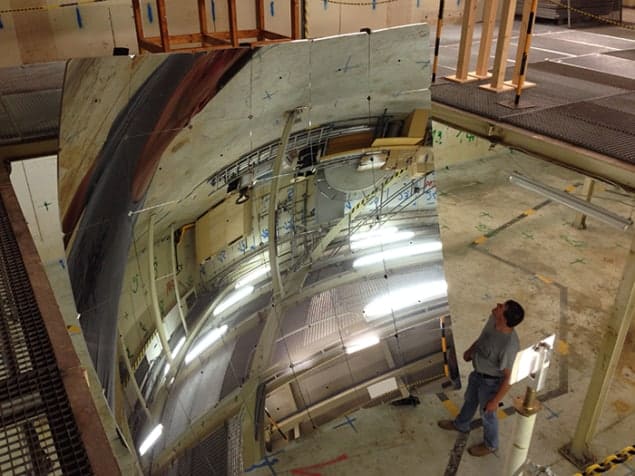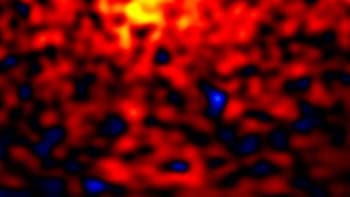
A large metallic mirror previously used as a prototype for a cosmic-ray observatory will be reused by physicists in Germany to hunt for “hidden photons”. These exotic and hitherto unseen cousins of normal photons could account for some dark matter – the mysterious and invisible substance that appears to account for about 85% of the matter in the universe.
Most dark-matter experiments try to detect weakly interacting massive particles (WIMPs), which are predicted by the theory of supersymmetry and interact with other matter only via the weak nuclear force and gravity. WIMP detectors aim to capture the tiny amounts of energy given off in collisions between the putative particles and atomic nuclei – usually in large detectors deep underground. However, about a quarter of a century has passed since the first such experiment started and not a single WIMP has been unambiguously detected.
Hidden photons are predicted in some extensions of the Standard Model of particle physics, and unlike WIMPs they would interact electromagnetically with normal matter. Hidden photons also have a very small mass, and are expected to oscillate into normal photons in a process similar to neutrino oscillation. Observing such oscillations relies on detectors that are sensitive to extremely small electromagnetic signals, and a number of these extremely difficult experiments have been built or proposed.
Many different experiments
“In the last few years, the interest in hidden photons has been growing,” says Jonathan Feng of the University of California, Irvine – partly because searches for other dark-matter candidates have “come up empty”. Also, physicists have realized that many different kinds of experiment can be built to try and detect hidden photons.
Now, Babette Döbrich and colleagues at DESY in Hamburg, the Karlsruhe Institute for Technology and other institutes in Europe are using a portion of a spherical, metallic mirror to look for hidden photons. This was suggested in 2012 by physicists in Germany in a paper called “Searching for WISPy Cold Dark Matter with a Dish Antenna”. The scheme exploits the fact that hidden photons would interact with electrons – albeit feebly – and when they strike a conductor they would set the constituent electrons vibrating. These vibrations would result in normal photons being emitted at right angles to the conductor’s surface.
A spherical mirror is ideal for detecting such light because the emitted photons would be concentrated at the sphere’s centre, whereas any background light bouncing off the mirror would pass through a focus midway between the sphere’s surface and centre. A receiver placed at the centre could then pick up the dark-matter-generated photons, if tuned to their frequency – which is related to the mass of the incoming hidden photons – with mirror and receiver shielded as much as possible from stray electromagnetic waves.
Ideal mirror at hand
Fortunately for the team, an ideal mirror is at hand: a 13 m2 aluminium mirror used in tests during the construction of the Pierre Auger Observatory and located at the Karlsruhe Institute of Technology. Döbrich and co-workers have got together with several researchers from Karlsruhe, and the collaboration is now readying the mirror by adjusting the position of each of its 36 segments to minimize the spot size of the focused waves. They are also measuring background radiation within the shielded room that will house the experiment. As for receivers, the most likely initial option is a set of low-noise photomultiplier tubes for measurements of visible light, which corresponds to hidden-photon masses of about 1 eV/C2. Another obvious choice is a receiver for gigahertz radiation, which corresponds to masses less than 0.001 eV/C2; however, this latter set-up would require more shielding.
The DESY/Karlsruhe experiment – provisionally named FUNK (Finding U(1)’s of a Novel Kind) – will not be the first to search for hidden photons. The CERN Resonant WISP Search (CROWS) at the CERN laboratory in Geneva, which has been running since 2011, looks for both hidden photons and other low-mass dark-matter particles, such as axions. Also looking is the Axion Dark Matter Experiment at the University of Washington in Seattle. Although, as its name suggests, this facility has been set up mainly to detect axions, it can nevertheless probe the existence of hidden photons down to very low interaction strengths. The advantage of FUNK over its rivals, says Döbrich, is that it will be able to operate across quite a broad range of frequencies – just how broad will depend on the availability of suitable electromagnetic detectors and the performance of the mirror.
Fritz Caspers of CERN applauds FUNK’s “very nice” design, but has concerns about how difficult it will be in practice to shield the mirror from electromagnetic interference. “The devil is always in the detail,” he says. He also wonders why Döbrich and colleagues did not “go directly” to look for emitted radio-frequency radiation using a radio telescope, with a dish up to perhaps 100 m across, rather than the smaller version they will use. “You could easily find much bigger mirrors in the world,” he says. Döbrich points out that in terms of optical measurements, their mirror is a very good choice.
The research is described in a preprint on arXiv.



